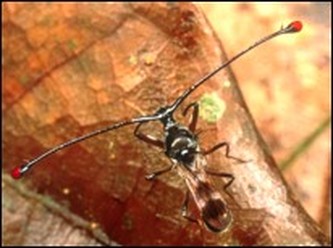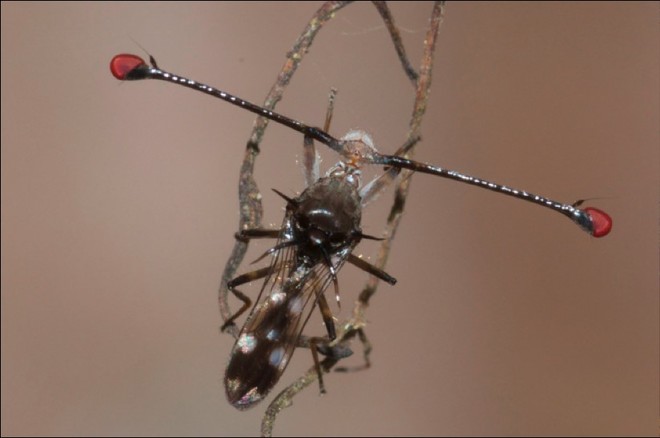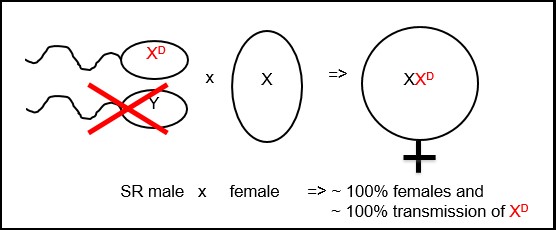Stalk-eyed flies reveal more than meets the eye - investigating sexual selection, speciation & genomic conflict Stalk-eyed flies are another one of nature’s curious and fascinating examples of biodiversity and an extreme result of sexual selective forces. These insects are true flies (Diptera) in the family Diospidae, typically distinguished by their unique eye stalks, from which they get their name. Dr. Gerald Wilkinson of the biology department at the University of Maryland has been conducting research on how genetic mechanisms may influence the outcome of evolution, specifically sexual selection, speciation and genomic conflict in stalk-eyed flies. All diospid flies have eye stalks, although some males display extremely long and seemingly disadvantageous stalks. When a species is sexually dimorphic, there is a physical difference between females and males, such as the difference in plumage between peacocks. In this case, the eye stalks are dimorphic with males having the longer eye stalks, and females having short eye stalks. While not all species of stalk-eyed flies are sexually dimorphic, sexual dimorphism has evolved independently several times in this genus. Based on Dr. Wilkinson’s research, the development of these intriguing eye stalks appears to be a product of sexual selection. The female flies favor mating with males with larger relative eye stalks to body size, pushing for directional selection for longer and longer eye stalks over evolutionary time. To test some predictions, Dr. Wilkinson artificially selected for both smaller eye stalk populations and larger eye stalk populations in the lab using Teleopsis dalmanni. Intriguingly, he found that after 20 generations, males from short eye stalk lines were producing only daughters and some males from longer eye stalk lines were producing predominantly sons. Dr. Wilkinson had stumbled onto X drive, an example of genomic conflict. Genomic conflict arises when certain genes selfishly try to push themselves into the next generation even at the expense of the host/population. In the populations of short stalk eyed flies, X drive influences spermatid elongation. Those that elongate properly contain the selfish driving element on the X chromosome (X) which in turn leads to a female biased population and spread of XD. Unchecked, this would lead to the eventual demise of the population. The discovery of X drive in T. dalmanni through artificial selection on male eye span, is a convincing catalyst for sexual selection. Because females that mate with XD carriers can lead to population extinction, there is pressure for females to avoid mating with these short stalk-eyed males. A preference for males with long eye-stalks can develop because 1) the population survives and 2) long eye-stalks are a good advertisement for the lack of XD. Because of this, Dr. Wilkinson predicted and found that eye span genes are X-linked and are in linkage disequilibrium with the driver element (i.e. short eye stalks genes stay close together with the driver element on XD). Sexual selection should eliminate drive except if recombination or imprecise female choice occasionally occurs.  Having unraveled some of the secrets to mating in stalk-eyed flies, Dr. Wilkinson turned his curiosity to another aspect. He was interested in identifying mechanisms for reproductive isolation. Which mechanism is more important, prezygotic isolation (e.g. differences in mating, sperm transfer, sperm survival, or fertilization) or postzygotic isolation (e.g. hybrid inviability or hybrid sterility) for the creation of new species? Using very similar species of southeast Asian stalk-eyed flies (cryptic species), Dr. Wilkinson and his lab determined that reproductive isolation increases with genetic distance and that those populations evolve postzygotic isolation rapidly, but prezygotic isolation relatively slowly over evolutionary time. In particular, hybrid males between closely related species were sterile. Dr. Wilkinson hypothesized this may be due to cryptic drive. This is where drive is hidden because another genetic element (a suppressor) is counteracting its effects. If the suppressor is removed the drive is suddenly active. Through breeding experiments he ultimately found the presence of both cryptic X and Y drive. Their suppressors were found on the non-sex chromosomes and were in the same genomic regions as factors that caused male hybrid sterility. So while stalk-eyed flies are a natural wonder to behold, it appears they have more to offer than meets the eye. From them we have learned that genomic conflict can influence sexually selected traits and that reproductive isolation can evolve rapidly due to post-mating sexual selection and X drive. Much of this work is ongoing and there is more to learn about genomic conflict and drive system using diospids as model organisms. References: Baker, R.H., Narechania, A., DeSalle, R., Johns, P.M., Reinhardt, J.A. and Wilkinson, G.S. 2015. Spermatogenesis drives rapid gene creation and masculinization of the X chromosome in stalk-eyed flies (Diopsidae). Genome Biology and Evolution (in review) Baker, R.H. and Wilkinson, G.S. 2010. Comparative genomic hybridization (CGH) reveals a neo-X chromosome and biased gene movement in stalk-eyed flies (genus Teleopsis). PLoS Genetics 6(9): e1001121 Christianson, S.J., Brand, C.L., and Wilkinson, G.S. 2011. Reduced polymorphism associated with X chromosome meiotic drive in the stalk-eyed fly, Teleopsis dalmanni. PLoS ONE 6:e27254. Christianson, S.J., Swallow, J.G., and Wilkinson, G.S. 2005. Rapid evolution of postzygotic reproductive isolation in stalk-eyed flies. Evolution 59(4):849-857 Reinhardt, J.A., Brand, C.L., Paczolt, K.A., Johns, P.M., Baker, R.H. and Wilkinson, G.S. 2014. Meiotic drive impacts expression and evolution of X-linked genes in stalk-eyed flies. PLoS Genetics 10(5):e1004362 Rose, E.G., Brand, C.L., and Wilkinson, G.S. 2014. Rapid evolution of asymmetric reproductive incompatibilities in stalk-eyed flies. Evolution 68:384-396 Wilkinson, G.S., Johns, P.M., Metheny, J.D., and Baker, R.H. 2013. Sex-biased gene expression during head development in a sexually dimorphic stalk-eyed fly. PLoS ONE 8:e59826 Wilkinson, G.S., Christianson, S.J., Brand, C.L., Shell, W. and Ru, G. 2014. Haldane's rule is linked to extraordinary sex ratios and sperm length in stalk-eyed fles. Genetics 198:1167-1181 Wilkinson, G. S., Presgraves, D.C. and Crymes, L. 1998. Male eye span in stalk-eyed flies indicates genetic quality by meiotic drive suppresion. Nature 391:276-279 gAbout the authors: Jackie Hoban is a first year Master's student in Paula Shrewsbury’s lab, researching biological control of the invasive, wood-boring pest, emerald ash borer, Agrilus planipennis (Coleoptera: Buprestidae). Jonathan Wang is a PhD student in Raymond St. Leger’s lab. He is studying Drosophila immunity and fungal pathogenesis. Mengyao Chen is a Master’s student in Dr. Leslie Pick’s Lab. Her research focuses on segmentation genes in Brown Marmorated Stink Bug (BMSB, Halyomorpha halys). Her current work is looking for orthologs of pair-rule genes in BMSB, and studying their expression and functions using RNA in situ hybridization and RNAi. Comments are closed.
|
Categories
All
Archives
June 2024
|
Department of Entomology
University of Maryland
4112 Plant Sciences Building
College Park, MD 20742-4454
USA
Telephone: 301.405.3911
Fax: 301.314.9290
University of Maryland
4112 Plant Sciences Building
College Park, MD 20742-4454
USA
Telephone: 301.405.3911
Fax: 301.314.9290



 RSS Feed
RSS Feed




